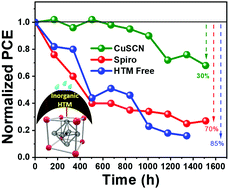Dual-functional inorganic CuSCN for efficient hole extraction and moisture sealing of MAPbI3 perovskite solar cells†
Abstract
Most high-performing organic–inorganic hybrid perovskite solar cells (PSCs) are fabricated using expensive organic hole-transporting materials (HTMs). The poor moisture- and thermal-stability of organic HTMs are significant factors contributing to the degradation of PSCs. Inorganic HTMs are promising cost-effective alternatives to achieve high efficiencies with enhanced stability. Here, we report PSC devices fabricated using a MAPbI3 perovskite film made by a one-step solution process and coated with inorganic CuSCN (PSC-CuSCN) and organic spiro-OMeTAD (PSC-spiro) HTMs in an n–i–p device configuration. This device performance is compared with that of the HTM-free (PSC-HTM-free) devices. The as-prepared devices were stored under dark ambient conditions (25 ± 3 °C and 50 ± 10% RH) for 1500 h, and their structural and morphological changes were investigated. The PSC-HTM-free and PSC-spiro devices showed a significant conversion of MAPbI3 to PbI2 phase. In contrast, MAPbI3 retained its perovskite structure in the PSC-CuSCN device and exhibited better photovoltaic performance for more than two months. Fresh PSC-spiro and PSC-CuSCN devices showed similar power conversion efficiencies (PCEs) of around 10%, while the PSC-HTM-free device showed a PCE of 6.1%. To compare the impact of atmospheric conditions on the stability of the device, they were stored under dark ambient conditions, and their performance was recorded for 1500 h. PSC-CuSCN retained nearly 70% of its initial PCE for more than 1500 h, whereas both the PSC-HTM-free and PSC-spiro devices exhibited similar performance degradation and retained only 30% of their initial PCE. The moisture resistance of the CuSCN film is understood from the high water contact angle (100°) between the film and the water droplets. We demonstrate that the inherent stability and the absence of dopants in the inorganic CuSCN HTM decelerate the degradation compared to its organic counterparts.

- This article is part of the themed collection: Celebrating Materials Science in India


 Please wait while we load your content...
Please wait while we load your content...